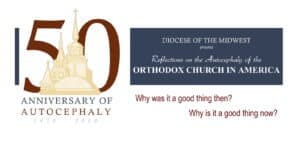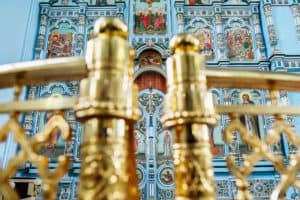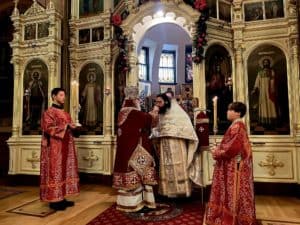PART VII
I was the choir director in a Serbian Orthodox Church, south of Pittsburgh, Pennsylvania, when I first heard about the formation of an “American Orthodox Church.” “This will be great, I thought,” even though I had no idea what the OCA or the Metropolia was.
Eleven years later, my wife and I started an OCA mission in northeastern Wisconsin. We had since been members of a Patriarchal Russian church in Michigan and a small struggling Greek Orthodox community in Wisconsin. We did not sense enough parish or diocesan commitment to this effort, and so my wife and I decided to go in another direction.
We first talked to Bishop Boris (Geeza) in the fall of 1980 about the possibility of an OCA mission in northeastern Wisconsin. Working with the Diocese of the Midwest was unlike any other jurisdictional interaction I had had to date.
First, there was no requirement for a down payment or a guarantee of a certain number of ethnics. As Bishop Boris said, “You come up with twenty-five people willing to take Holy Communion as Orthodox Christians and we can do business.”
About eight months later, July 1981, we had our first service. Father Hilary Madison was our priest and the Northeast Wisconsin Orthodox Mission began. At our patronal saint’s day dinner this year, our parish, St. Matthew in Green Bay, Wisconsin, will celebrate its 39th anniversary.
Yes, the formation of the OCA in 1970 was good for Orthodox Christian witness in this country. First, its principle hierarch was in the US—no longer beholden to any authorities abroad.
Second, the OCA had a commitment to domestic mission that was unusual. Our St Matthew’s mission survived for its first five years with one of the first mission planting grants the Midwest Diocese had ever given.
Third, the expectation that English be used for worship was a plus. Most of us had come from very ethnic parishes, but we knew that, to make a go of it in this part of the country, we had to say good-bye to the old languages.
Fourth, the bishops made themselves accessible to us. Even being up in the ‘hinterlands,” we enjoyed regular visits from Bishop Boris and Bishop Job and knew that we were always on their radar screen.
Having said all this, there are aspects of the OCA, at the national and diocesan levels, that have concerned me. Perhaps in the larger scheme of things, the discomfort over the formation of the OCA may not mean much. In daily practice, OCA parishes have participated as equally valid partners in interjurisdictional services and celebrations. But, even as the primacy of the Ecumenical Patriarch has been contested lately, not having his blessing has continued to cast a shadow on the OCA’s legitimacy.
I think that there was one systemic flaw that marked the OCA’s inception. Perhaps as an inducement to other prospective member jurisdictions, the OCA created, or allowed, overlapping diocesan jurisdictions just like the redundancy that has been so loudly criticized at the national level. Why do we still have more than one bishop presiding over the same territory of the OCA?
Related to this, I also wonder what the OCA has done to reach out to the other patriarchal jurisdictions that chose not to join.
There have been periods of absent hierarchical leadership in some OCA dioceses. Finding viable candidates for these offices appears to be a problem. Does this have to do with seminaries being located so close to each other as opposed to being more strategically placed? Is it because fewer cradle Orthodox men are being inspired to enter the clergy as compared with the growing number of converts?
Ethnicity still lingers in the OCA. For parties, dances, fundraiser, this is great. But not for worship. Are some churches still not using English exclusively in their services? Are there some churches that still include “Russian,” or “Bulgarian,” or “Romanian” in their names? Why does the OCA calendar include “old calendar” dates?
Having attended Diocesan Assembly meetings since the early 80’s, I’ve become frustrated with the “head count” versus “parish tithing” arguments that have gone on for years. I was glad to hear that the Midwest Diocese has moved to this for 2019. However, I do have some concerns.
Using the parishes’ income figures from 2017 does not seem the right approach. The tithe should be based on the most recent income figures available, not on those that are two years old. I also realize that the Diocese wants to work with a standard tithe amount from each parish, but if it is based on what each church has taken in each month, this may not be possible. More discussion between the Diocese and the parishes is needed here and soon.
Generally speaking, autocephaly is the only route to go in this country and I believe that other groups may be coming to this realization also. One is Orthodox Christian Laity of which I am a member. Composed of mostly Greek Orthodox faithful, the calls for autocephaly and Orthodox jurisdictional unity in this group have increased.
So, should these Greek parishes just come into the OCA? Should the OCA consent to being absorbed by the larger Greek jurisdiction if it became independent of the Ecumenical Patriarch?
Are hopes of total Orthodox American unity futile in the face of continuing, and in some cases increasing, expressions of allegiance to Patriarchates abroad? Should we be satisfied with just managing our own little parishes without worrying about any Orthodox life outside of our bounds?
My answer to these questions is a resounding “No.” But I cannot say that I have confidence that the hierarchs of the OCA and the other Orthodox jurisdictions share my sentiments.




